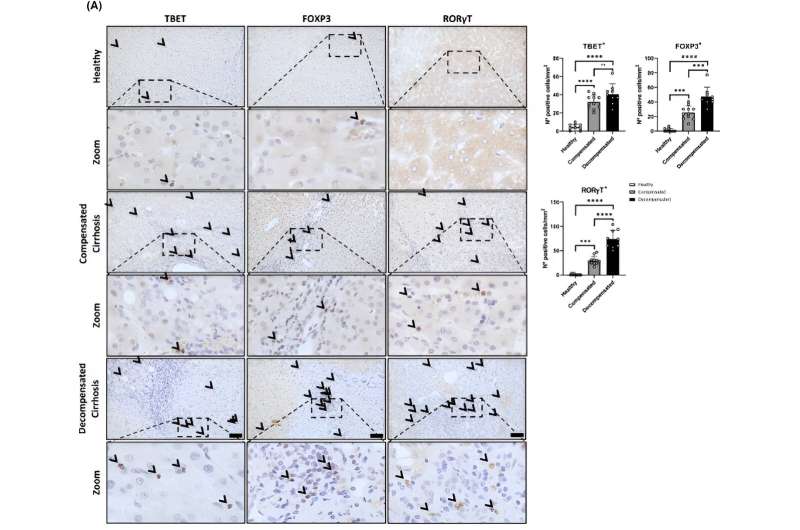This article has been reviewed according to Science X's editorial process and policies. Editors have highlighted the following attributes while ensuring the content's credibility:
fact-checked
trusted source
proofread
Study advances understanding of liver immune response in cirrhosis

The Department of Clinical Medicine at the Miguel Hernández University of Elche (UMH) leads research on the immune system's role in advanced chronic liver disease. Through various experiments on mouse cirrhosis models and human tissues, researchers have examined how the protein LSECtin interacts with the liver's immune response.
Their results show that decreasing LSECtin levels increases a specific type of immune cells in the liver that can negatively contribute to the disease progression. This suggests that restoring these levels could potentially restore altered liver functions in cirrhosis.
The UMH's Hepatic and Intestinal Immunobiology Group, associated with IDIBE, and researchers from other Spanish institutions, have published these findings in Liver International.
Some immune system cells specialized in recognizing pathogenic microorganisms such as bacteria, viruses, or fungi have so-called "innate receptors." These receptors are the first line of defense against infections, triggering rapid and general immune responses.
Unlike adaptive receptors, which require a "learning" process of the immune system, as with some vaccines, innate receptors do not change their specificity throughout an individual's life. The study led by the UMH focuses on type C lectins, a type of innate receptor relevant to cirrhosis.
Dr. Rubén Francés, director of the UMH's Hepatic and Intestinal Immunobiology Group and study leader, explains that liver cirrhosis is the final stage of various chronic liver diseases. During cirrhosis, there is an imbalance in the immune system, during which different innate receptors play a fundamental role in controlling inflammation. Hence, the interest in studying lectins.
Type C lectins help bind and process antigens from pathogens, promote the adhesion of leukocytes to enter liver tissue, and modulate T lymphocyte responses. One of these lectins, called LSECtin or (CLEC4G), is mainly present in the cells lining the liver's blood vessels.
"LSECtin plays a key role in regulating the liver's immune system," explains the UMH researcher, "as its activity as an innate receptor in the endothelium modulates the response of these cells to microbial stimuli, they are usually exposed to and modulates the function of inflammatory lymphocytes through specific ligands."
The activation of innate receptors triggers a series of responses to eliminate pathogens and stimulate the immune system. "Therefore, they are essential for the early recognition of threats to the body," explains Francés.
UMH Immunology researcher Esther Caparrós Cayuela, co-leader of the study, explains how this research was carried out on mouse liver blood vessel cells: "Mediators of the immune system modulate the expression of LSECtin. When there is inflammation, the expression of this lectin decreases, while anti-inflammatory mediators activate it." Likewise, the team found a lower expression of LSECtin in both chronic liver damage models in mice and in cirrhotic patients.
The loss of this protein during pathology may contribute to the characteristic inflammation damage of cirrhosis. "In fact," says the UMH Department of Clinical Medicine researcher, "we found a close correlation between the loss of LSECtin and the recruitment of pro-inflammatory lymphocytes (called Th17) in cirrhotic livers."
Additionally, the team of researchers restored the activity of the LSECtin protein in cirrhotic animal cells by applying treatment with anti-inflammatory immune mediators. This achievement, explains Caparrós, suggests that the recovery of LSECtin could be a potential therapeutic strategy.
More information: Sebastián Martínez‐López et al, Cirrhosis‐downregulated LSECtin can be retrieved by cytokines, shifts the TLR‐induced LSECs secretome and correlates with the hepatic Th response, Liver International (2024). DOI: 10.1111/liv.15836





















